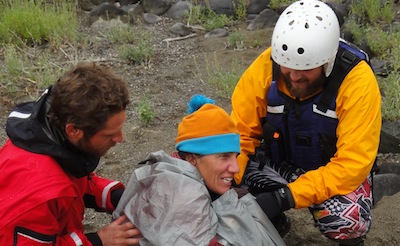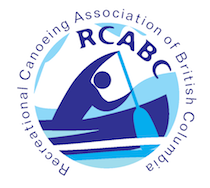
British Columbia's waterways normally range from cold to very cold. There are a some warm lakes and rivers in the summer, but in many cases the water was snow not too long ago. Dressing appropriately is vital to not just being comfortable but also to prevent hypothermia (lowering of the body's core temperature), which is one of your biggest safety concerns.
COLD WATER PREPAREDNESS TOPICS:
Hypothermia is a lowering of the body's core temperature (<37C). It can be life threatening.
Hypothermia can result from a combination of any of the following:
- immersion
- cold air temperature
- wind
- rain
- fatigue and poor health
- poor nutrition and hydration
- damp or wet clothing from sweating or immersio
- insufficient clothing
Even mild hypothermia can impair your judgement and use of your extremities, particularly your hands and fingers. Mild hypothermia can quickly progress to moderate or severe hypothermia which are very dangerous, particularly in wilderness settings. Severe hypothermia is very difficult to treat.
Knowing how your body responds in cold weather or water is important. There are significant differences between males and females, larger and smaller people and particularly with children. Your body loses heat 25 times faster in water than in air, and much faster in moving water (or if you're swimming).
RCABC and Wilderness First Aid courses can teach more about preventing, recognizing and treating hypothermia.
Back to Top...
1-10-1 RULE FOR COLD WATER IMMERSION
Sudden immersion in cold water is quite shocking for most people unless you're wearing immersion gear (wetsuit or drysuit).
Cold Water Boot Camp's Dr. Gordon Giesbrecht has a 1 – 10 – 1 Rule that all canoeists should be aware of:
- 1 Minute - COLD SHOCK. An initial deep and sudden Gasp followed by hyperventilation that can be as much as 600-1000% greater than normal breathing. You must keep your airway clear or run the risk of drowning. Cold Shock will pass in about 1 minute. During that time concentrate on avoiding panic and getting control of your breathing. Wearing a lifejacket during this phase is critically important to keep you afloat and breathing.
- 10 Minutes - COLD INCAPACITATION. Over approximately the next 10 minutes you will lose the effective use of your fingers, arms and legs for any meaningful movement. Concentrate on self rescue initially, and if that isn't possible, prepare to have a way to keep your airway clear to wait for rescue. Swim failure will occur within these critical minutes and if you are in the water without a lifejacket, drowning will likely occur. [A good option is to stay with your canoe if you are alone– it is a flotation device and you'll be more visible.]
- 1 Hour - HYPOTHERMIA. Even in ice water it could take approximately 1 hour before becoming unconscious due to Hypothermia. If you understand the aspects of hypothermia, techniques of how to delay it, self rescue and calling for help, your chances of survival and rescue will be dramatically increased.
Go to the Cold Water Boot Camp website for very interesting studies, advice, videos and resources.
Back to Top...
CLOTHING FOR CANOEING
Choosing proper clothing for canoeing can not only make you more comfortable, it can save your life. It is often a difficult choice. Do you dress for the air temperature and current weather or for the water temperature in case you capsize? This is an ongoing decision making process even for experienced canoeists.
Clothing systems fall into these 3 groups:
- SYNTHETIC LAYERS – This is similar to clothing for hiking; a light synthetic base layer, a mid layer for insulation and a shell top and bottom for wind and precipitation. Wear the layers that are appropriate. Don't wear cotton (see below). This system is comfortable and will dry quickly, but offers little insulation while in the water.
- NEOPRENE – A "farmer john" sleeveless wetsuit is a good choice for immersion and staying warm after immersion. Couple it with a synthetic shirt or sweater and a paddling jacket with cuffs and neck that seal. You will be wet if you go in the water, but you'll stay much warmer.
- DRY SUIT – A dry suit keeps you completely dry. It has neoprene gaskets and you can wear whatever amount of insulation is needed underneath. They are very warm, but it is easy and comfortable to cool off by getting in the water. They don't restrict your range of motion the way a wetsuit does. They can be breathable as well
How to choose? A good question to ask yourself is what is the upcoming level of risk, on a scale of low to high? For example:
HIGH RISK EXAMPLE - you are going alone, on cold water in October, making some large crossings with little chance of self rescue.
For higher risk situations wear a wetsuit and paddling jacket or a drysuit.
LOW RISK EXAMPLE - you are in a group that stays close to shore when possible and stays close together, knows how to rescue, is aware of the weather and hazards, and the weather conditions are good. For a low risk situation experienced canoeists often choose synthetic clothing, such as the layering system used for hiking.
USING COTTON CLOTHING is discouraged for canoeing because it absorbs a lot of water and draws heat out of your body as it evaporates. This process goes on for a long time and can become quite dangerous by setting the stage for hypothermia. Cotton also takes a long time to dry if you're not wearing it, which is inconvenient on a multi day trip.
Don't let warm weather lull you into not wearing immersion gear. Remember, water steals your heat 25 times faster than air, and much faster if you or the water is moving or if you are swimming.
Back to Top...
If you find yourself in the water with no immediate possibility of rescue, you have some serious choices to make:
- If you have signals (flares, whistle, waving a paddle, etc) be ready to use them if a possible rescue party is seen.
- Stay with your canoe unless you are very close to shore and are a good swmmer. Many people drown when the overestimate their swimming ability, and don't take cold water temperature into account.
- Stay calm and still. Moving your body in the water increases heat loss.
- If you can, get as much of your body out of the water as possible. Getting onto your overturned canoe is sometimes an option.
- If alone, curl up into the HELP position (Heat Escape Lessening Position), which is more or less the fetal position.
- If in a group, link your arms together in a circle facing one another everyone in HELP position.
- Stay mentally strong and fight to survive! Studies indicate that this increases your chance of survival.



















